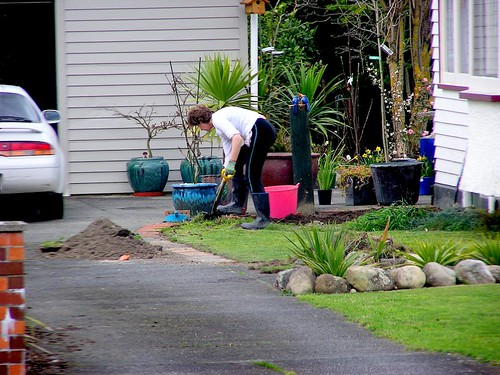How can our over 65’s keep active while self-isolating?
If you are self-isolating this summer, your movements are limited and so too are the options for exercising. While golf courses have opened in recent weeks and gyms and sports centres due to reopen again soon, but for those self-isolating, it’s time to think of other ways to get your weekly exercise in. It is still possible to get your daily steps, Covid or no Covid.
Gardening:
The queues outside our local garden centres tells us gardening is in fashion. And we garden not just to landscape our lawns and pretty our porches, we should garden as a form of physical activity. Scientists have found numerous health benefits from gardening. It increases your physical activity levels, reduces BMI (body mass index: you can calculate your BMI here: https://www.safefood.eu/Healthy-Eating/BMI-calculator.aspx) and is good for your mind too; boosting attention, wellbeing and reducing anxiety and stress levels [1]. Research has also found gardening benefits older adults’ flexibility and body strength and reduces bodily pain [2]. Psychologists are constantly researching the benefits of spending time in nature and your garden is a form of nature. It is thought that nature or green environments have a restorative effect on humans, restoring our physical and mental health [3]. Doing a bit in the garden is certainly therapeutic for both mind and body. If you are cocooning, many garden stores are doing home deliveries so you can avoid going to the store itself.
Walking:
Walk your way to better health. Walking is a simple exercise but has an abundance of benefits for us, with regular walking habits associated with a lower risk of heart disease and diabetes, improved joint strength and reducing stress and depression [4, 5]. If you are staying within the limits of your home, try to move around more during the day. Go for a walk in the garden, even walk from room to room in your house or do a few laps around your neighbourhood. Every little bit of exercise helps, small doses do add up!
Many people like to use technology to keep track of their daily activity, with activity trackers like Fitbits being popular. If you have a smartphone, you can easily set up a free app to count your steps (as long as you take the phone with you as you walk!). We were recently involved in a community research project with older adults using activity trackers to promote walking. Local active retired group, Young @ Heart Douglas secured funding for activity trackers for their members and started an initiative called ‘StepUp to Your Health’. Phil Goodman, organiser of the initiative explains; ‘We wanted to engage people in a walking initiative in a fun and friendly atmosphere. We all know exercising is good for the mind and body and we felt this community project would allow people come together with the shared goal of staying fit and healthy. We’re very grateful to the Manager of Douglas Village Shopping Centre, Bartosz Mieszala for sponsoring the activity trackers.’ Participants were given a tracker for 6 weeks to monitor their normal walking habits and were encouraged to increase their steps if possible but no target number of steps was set. Participants found the activity tracker a ‘good motivator’ and felt ‘it would push you on’ as many ‘became more aware of [their] own activity’. One member explained; ‘it did encourage me to walk further, park further away in the car park and you know it encouraged me to build up the steps’. Some found a lasting benefit from the initiative; ‘In town… I stopped using the escalator and I use the stairs…and I still use the stairs now [post-initiative]…so I thought if I only got just that one thing from it, it was probably worth doing.’
We checked in on the group to see how they were finding exercising in lockdown. Many had started to walk around their homes, as one lady put it; ‘I send myself on a trek up and down [the stairs] four or five times a day’, with some keeping tabs on their number of stair climbs. Others made use of their outdoor spaces, ‘I potter around the garden’ or make use of local greenspaces ‘I live across the road from the woods so I’m in an ideal position’. This walking programme was a great success and we hope to continue the initiative soon. Keep an eye out for local walking groups or active retired organisations who may organise a walking group in your neighbourhood. Find your local active retired group here: https://activeirl.ie/your-local-group/.
Armchair Exercises:
Public health guidelines recommend those over 65 to include some strength training into their week in order to maintain muscle mass. While the gym may be out of the question at the moment, you can do strength training from home. The HSE have a useful and easy to follow series of armchair exercises for improving your strength and mobility: https://www.healthpromotion.ie/hp-files/docs/HPM00487.pdf. For guided home exercise sessions, the not-for-profit Siel Bleu has a series of Youtube videos you can follow, simply click here: http://www.sielbleu.ie/home/at-home-guides/.
Whether its walking, gardening or home workouts, find a physical activity you enjoy and keep moving this summer!
References:
[1] Soga, M., Gaston, K. J., & Yamaura, Y. (2017). Gardening is beneficial for health: A meta-analysis. Preventive Medicine Reports, 5, 92-99.
[2] Wang, D., & MacMillan, T. (2013). The benefits of gardening for older adults: a systematic review of the literature. Activities, Adaptation & Aging, 37(2), 153-181.
[3] Kaplan, S. (1995). The restorative benefits of nature: Toward an integrative framework. Journal of environmental psychology, 15(3), 169-182.
[4] Murtagh, E. M., Murphy, M. H., & Boone-Heinonen, J. (2010). Walking–the first steps in cardiovascular disease prevention. Current opinion in cardiology, 25(5), 490.
[5] Lee, I. M., & Buchner, D. M. (2008). The importance of walking to public health. Medicine & Science in Sports & Exercise, 40(7), S512-S518.



